The Characteristics of Oil Migration due to Water Imbibition in Tight Oil Reservoirs
Abstract
1. Introduction
2. Experimental Materials and Methods
2.1. Rock Samples and Fluids
2.2. Experimental Apparatus
2.3. Experimental Procedure
- (1)
- Before the experiments, the tight reservoirs samples should be cleaned to remove the residual oil. The cleaning solvent are mixture of toluene and ethyl ether, and the process lasts about one month.
- (2)
- The samples were placed in a saturating device and evacuated for 2 to 3 h to remove air. Then, the kerosene was injected under a 20 MPa pressure. The saturation process lasted for 72 h to fill the samples fully with kerosene.
- (3)
- The samples were taken out and the mass and size of the samples were measured. They were immersed in the MnCl2 solution. After a period of time, the masses of the samples were measured and the T2 spectra was tested using NMR apparatus.
- (4)
- Step (3) was repeated, and the T2 spectra variation was drawn over soaking time.
3. Experimental Results and Discussions
3.1. Effects of Pore Size Distribution on Oil Migration
3.2. Effects of Natural Fractures on Oil Migration
3.3. Effects of Fracture Propagation on Oil Migration
3.4. Effects of Clay Mineral on Oil Migration
3.5. Scaling the Imbibition Results of Different Reservoirs
4. Conclusions
- (1)
- Concerning the tight reservoirs without clay minerals and micro-fractures, the oil migration due to water imbibition was mainly determined by the pore size. The smaller pores corresponded to a larger capillary pressure and a stronger imbibition capacity. Therefore, the oil of micro-pores tended to migrate into small and largish pores and that of the small and largish pores tended to migrate into large pores. The small and largish pores acted as bridges to connect the micro-pores and large pores. Compared with small and largish pores and large pores, the micro-pores had the largest oil recovery.
- (2)
- As the soaking time increased, the water preferentially entered the natural micro-fractures, expelling the oil in the micro-fractures. Subsequently, the oil in the small pores was slowly expelled. Compared with the matrix pores, micro-fractures have smaller flow resistance and are more conducive to water and oil flow.
- (3)
- The clay minerals of middle content may have induced the fracture propagation. A large amount of oil migrated into the new micro-fractures during the process of micro-fracture propagation. In contrary to the inhibitory effect of natural micro-fractures, the new micro-fractures could have contributed to the oil migration from micro-pores into large pores. The clay minerals of high content can completely decentralize pore structure and significantly increase the imbibition oil recovery at atmospheric pressure. Under the reservoir condition, the effects of excessive clay minerals need to be studied in the future. More clay minerals may result in water sensitivity damage and do not contribute to oil production.
Author Contributions
Funding
Acknowledgments
Conflicts of Interest
References
- Xu, G.; Shi, Y.; Jiang, Y.; Jia, C.; Gao, Y.; Han, X.; Zeng, X. Characteristics and Influencing Factors for Forced Imbibition in Tight Sandstone Based on Low-Field Nuclear Magnetic Resonance Measurements. Energy Fuels 2018, 32, 8230–8240. [Google Scholar] [CrossRef]
- Liu, P.; Zhang, X.; Wu, Y.; Li, X. Enhanced oil recovery by air-foam flooding system in tight oil reservoirs: Study on the profile-controlling mechanisms. J. Pet. Sci. Eng. 2017, 150, 208–216. [Google Scholar] [CrossRef]
- Gu, X.Y.; Pu, C.; Huang, H.; Huang, F.; Li, Y.; Liu, Y.; Liu, H. Micro-influencing mechanism of permeability on spontaneous imbibition recovery for tight sandstone reservoirs. Pet. Explor. Dev. 2017, 44, 1003–1009. [Google Scholar] [CrossRef]
- Todd, H.B.; Evans, J.G. Improved Oil Recovery IOR Pilot Projects in the Bakken Formation. In Proceedings of the SPE Low Perm Symposium, Denver, CO, USA, 5–6 May 2016. [Google Scholar]
- Lan, Q.; Ghanbari, E.; Dehghanpour, H. Water Loss Versus Soaking Time: Spontaneous Imbibition in Tight Rocks. In Proceedings of the SPE/EAGE European Unconventional Resources Conference and Exhibition, Vienna, Austria, 25–27 February 2014. [Google Scholar]
- Jiang, Y.; Shi, Y.; Xu, G.; Jia, C.; Meng, Z.; Yang, X.; Zhu, H.; Ding, B. Experimental Study on Spontaneous Imbibition under Confining Pressure in Tight Sandstone Cores Based on Low-Field Nuclear Magnetic Resonance Measurements. Energy Fuels 2018, 4, 56–78. [Google Scholar] [CrossRef]
- Xu, J.; Sun, B.; Chen, B. A hybrid embedded discrete fracture model for simulating tight porous media with complex fracture systems. J. Pet. Sci. Eng. 2019, 174, 131–143. [Google Scholar] [CrossRef]
- Shen, W.; Li, X.; Lu, X.; Guo, W.; Zhou, S.; Wan, Y. Experimental study and isotherm models of water vapor adsorption in shale rocks. J. Nat. Gas Sci. Eng. 2018, 52, 484–491. [Google Scholar] [CrossRef]
- Ezulike, O.D.; Ghanbari, E.; Siddiqui, S.; Dehghanpour, H.; Sidduqui, S. Pseudo-steady state analysis in fractured tight oil reservoirs. J. Pet. Sci. Eng. 2015, 129, 40–47. [Google Scholar] [CrossRef]
- Ge, H.; Yang, L.; Shen, Y.; Ren, K.; Meng, F.; Ji, W.; Wu, S. Experimental investigation of shale imbibition capacity and the factors influencing loss of hydraulic fracturing fluids. Pet. Sci. 2015, 12, 636–650. [Google Scholar] [CrossRef]
- Yang, L.; Zhang, X.; Zhou, T.; Lu, X.; Zhang, C.; Zhang, K. The effects of ion diffusion on imbibition oil recovery in salt-rich shale oil reservoirs. J. Geophys. Eng. 2019, 16, 525–540. [Google Scholar] [CrossRef]
- Dehghanpour, H.; Lan, Q.; Saeed, Y.; Fei, H.; Qi, Z. Spontaneous imbibition of brine and oil in gas shales: Effect of water adsorption and resulting micro fractures. Energy Fuels 2013, 27, 3039–3049. [Google Scholar] [CrossRef]
- Ghaderi, S.M.; Clarkson, C.R.; Ghanizadeh, A.; Barry, K.; Fiorentino, R. Improved Oil Recovery in Tight Oil Formations: Results of Water Injection Operations and Gas Injection Sensitivities in the Bakken Formation of Southeast Saskatchewan. In Proceedings of the SPE Unconventional Resources Conference, Calgary, AB, Canada, 15–16 February 2017. [Google Scholar]
- Yuan, J.; Jiang, R.; Zhang, W. The workflow to analyze hydraulic fracture effect on hydraulic fractured horizontal well production in composite formation system. Adv. Geo-Energy Res. 2018, 2, 319–342. [Google Scholar] [CrossRef]
- Habibi, A.; Xu, M.; Dehghanpour, H.; Bryan, D.; Uswak, G. Understanding Rock-Fluid Interactions in the Montney Tight Oil Play. In Proceedings of the SPE/CSUR Unconventional Resources Conference, Calgary, AB, Canada, 20–22 October 2015. [Google Scholar]
- Hu, Q.H.; Ewing, P.R.; Dultz, S. Low pore connectivity in natural rock. J. Contam. Hydrol. 2012, 133, 76–83. [Google Scholar] [CrossRef] [PubMed]
- Tian, X.; Cheng, L.; Cao, R.; Wang, Y.; Zhao, W.; Yan, Y.; Liu, H.; Mao, W.; Zhang, M.; Guo, Q. A new approach to calculate permeability stress sensitivity in tight sandstone oil reservoirs considering micro-pore-throat structure. J. Pet. Sci. Eng. 2015, 133, 576–588. [Google Scholar] [CrossRef]
- Brace, W.F.; Walsh, J.B.; Frangos, W.T. Permeability of granite under high pressure. J. Geophys. Res. Space Phys. 1968, 73, 2225–2236. [Google Scholar] [CrossRef]
- Meng, M.; Ge, H.; Ji, W.; Wang, X. Research on the auto-removal mechanism of shale aqueous phase trapping using low field nuclear magnetic resonance technique. J. Pet. Sci. Eng. 2016, 137, 63–73. [Google Scholar] [CrossRef]
- Shouxiang, M.; Morrow, N.R.; Zhang, X. Generalized scaling of spontaneous imbibition data for strongly water-wet systems. J. Pet. Sci. Eng. 1997, 18, 165–178. [Google Scholar] [CrossRef]
- Akin, S.; Schembre, J.; Bhat, S.; Kovscek, A. Spontaneous imbibition characteristics of diatomite. J. Pet. Sci. Eng. 2000, 25, 149–165. [Google Scholar] [CrossRef]
- Yang, L.; Ge, H.; Shi, X.; Cheng, Y.; Zhang, K.; Chen, H.; Shen, Y.; Zhang, J.; Qu, X. The effect of microstructure and rock mineralogy on water imbibition characteristics in tight reservoirs. J. Nat. Gas Sci. Eng. 2016, 34, 1461–1471. [Google Scholar] [CrossRef]
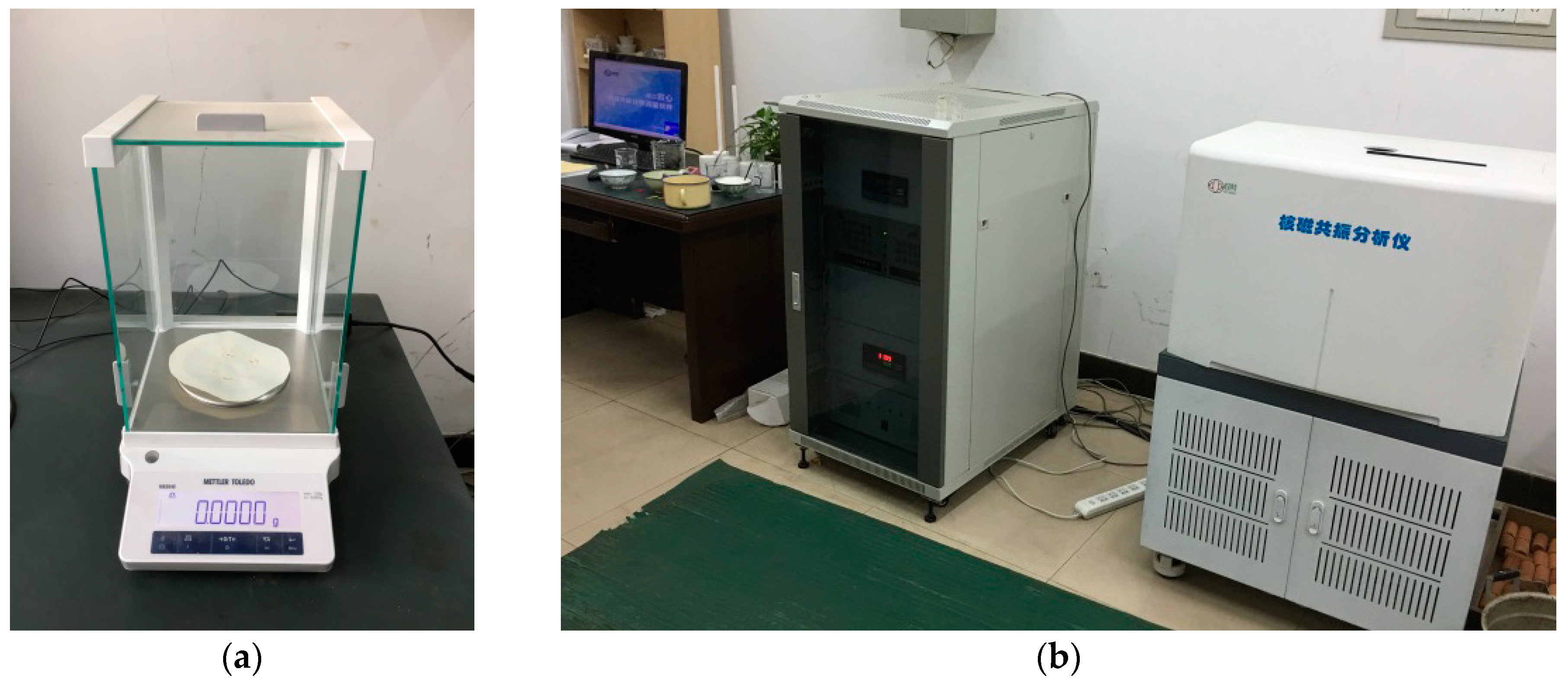
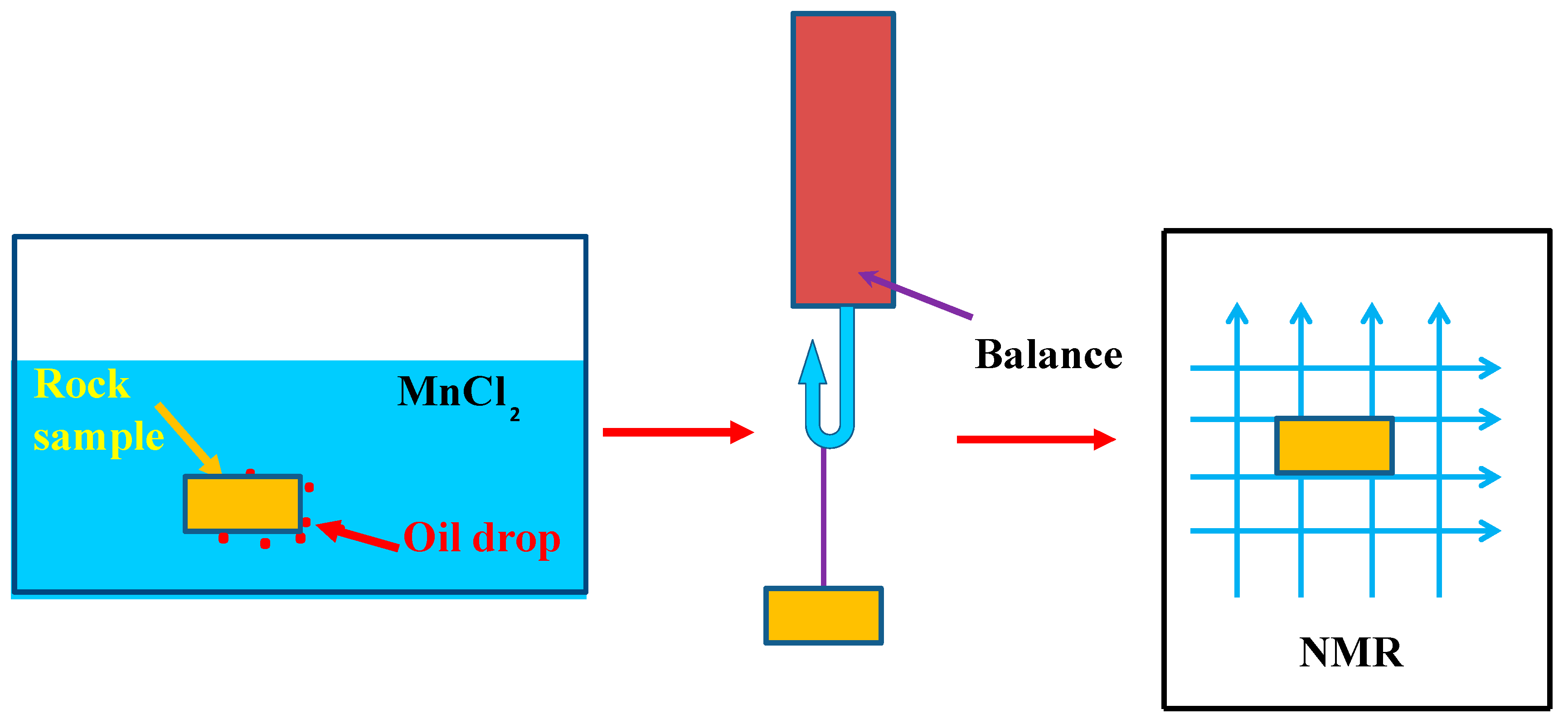

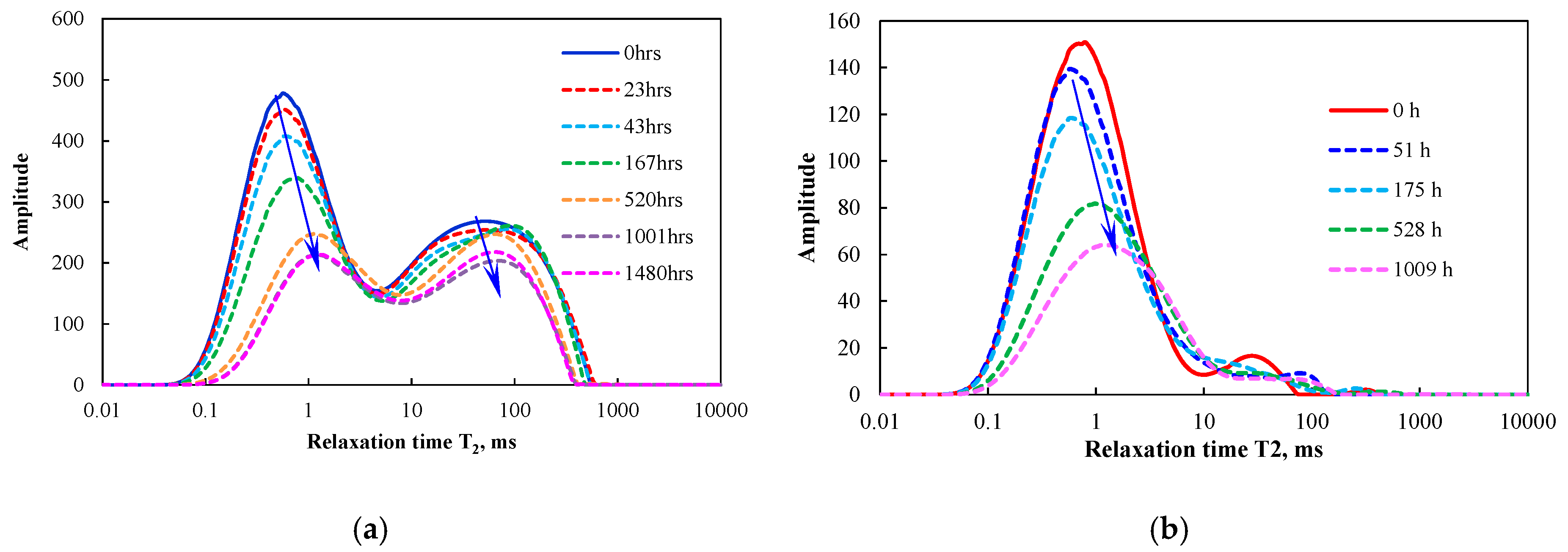
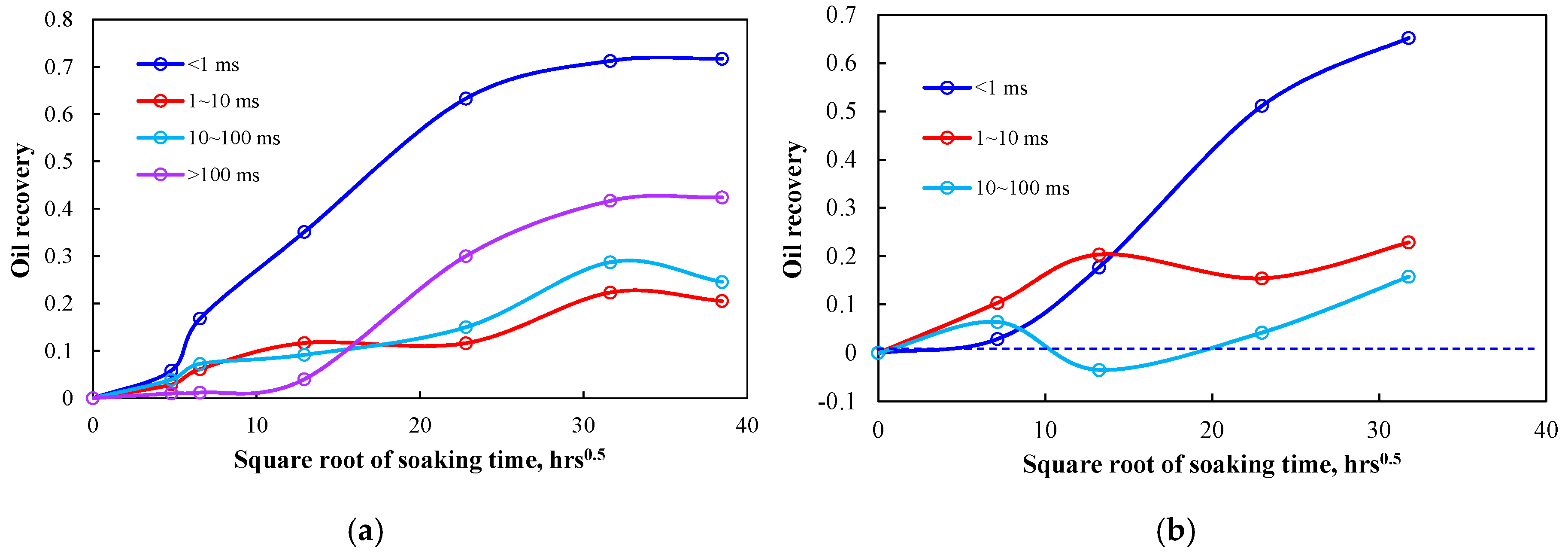
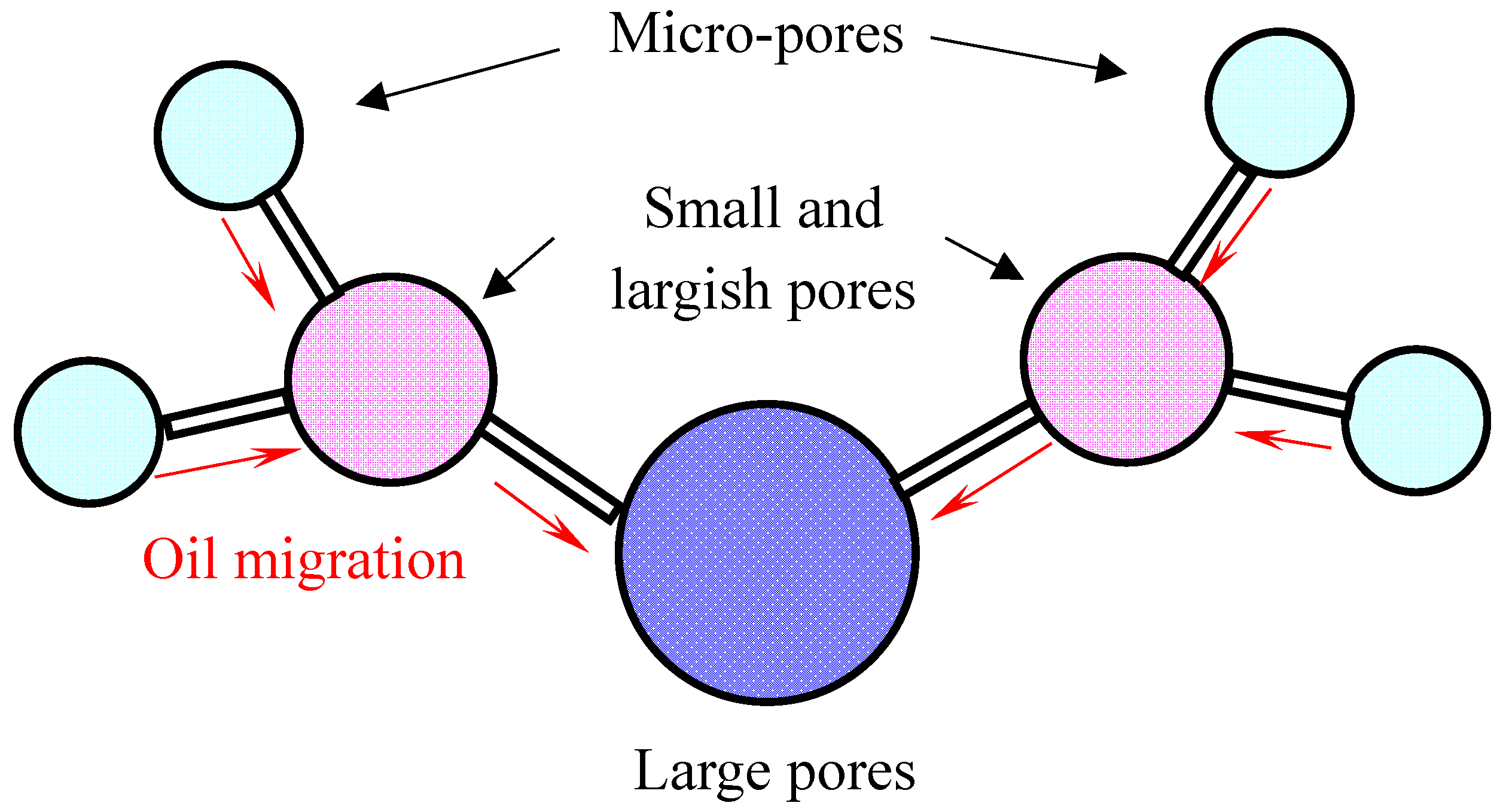


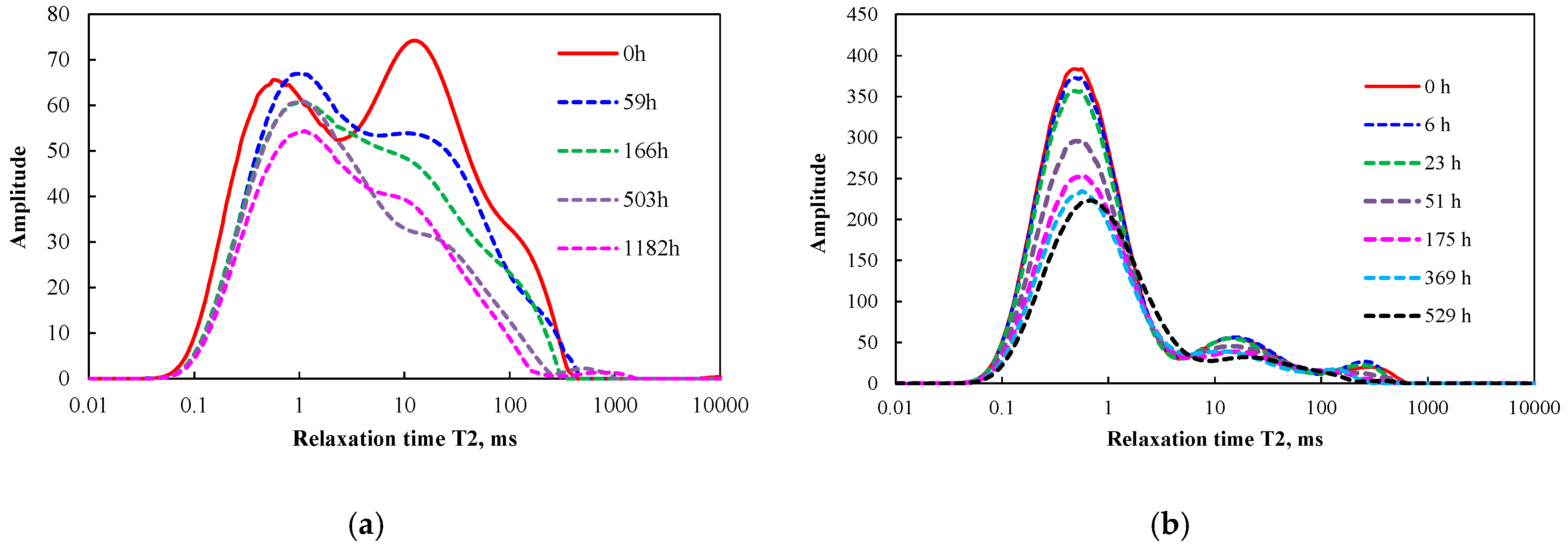
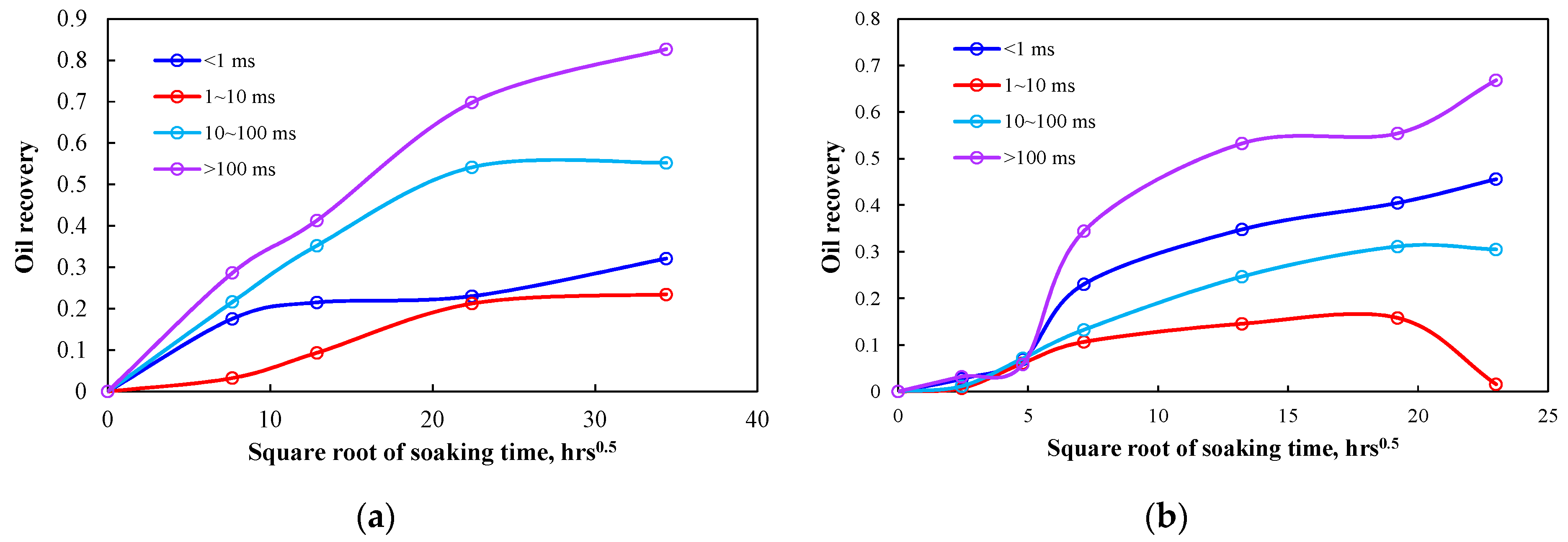


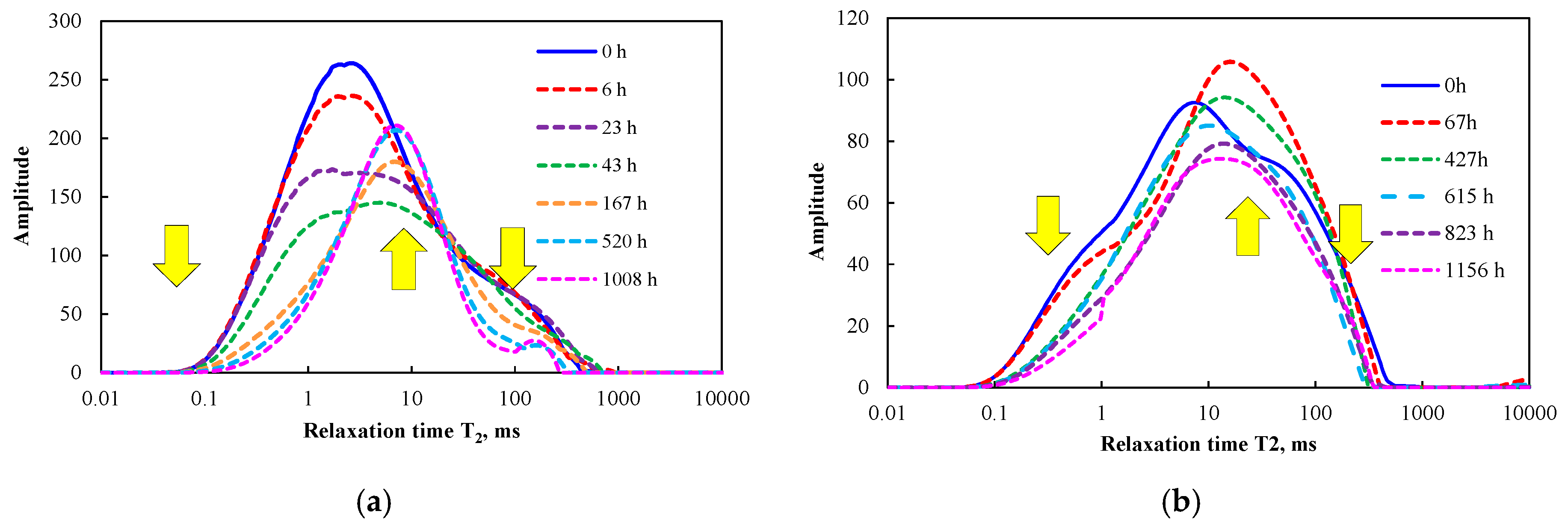


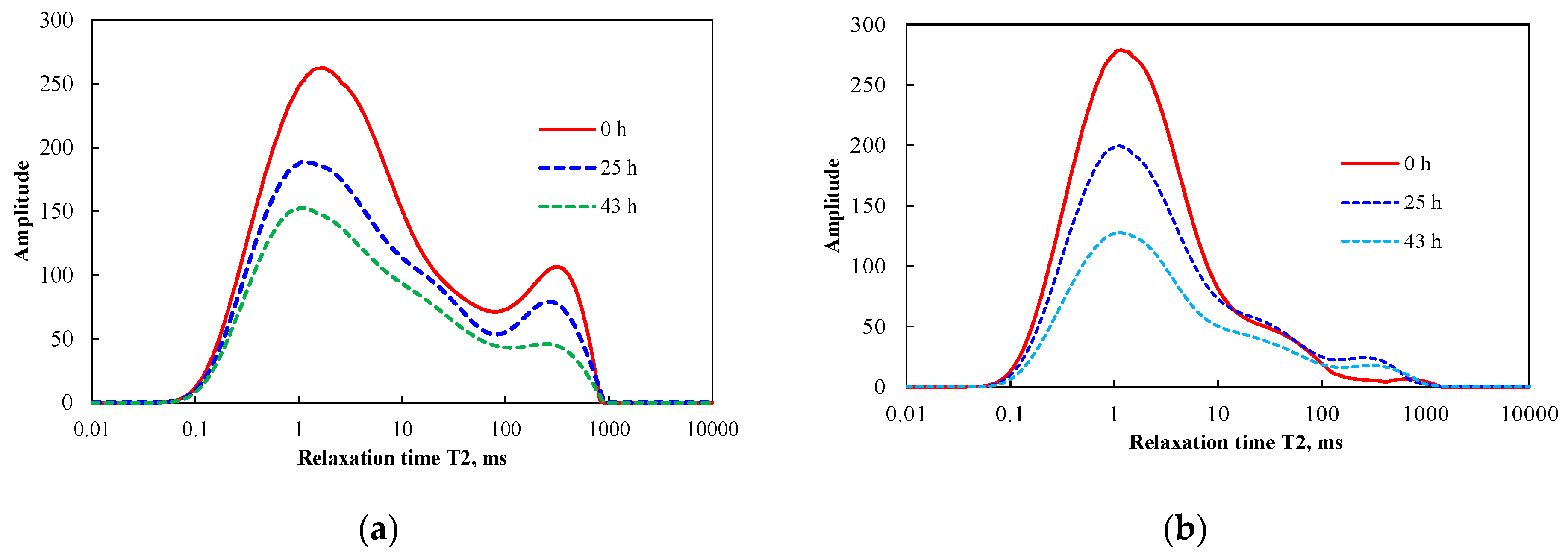
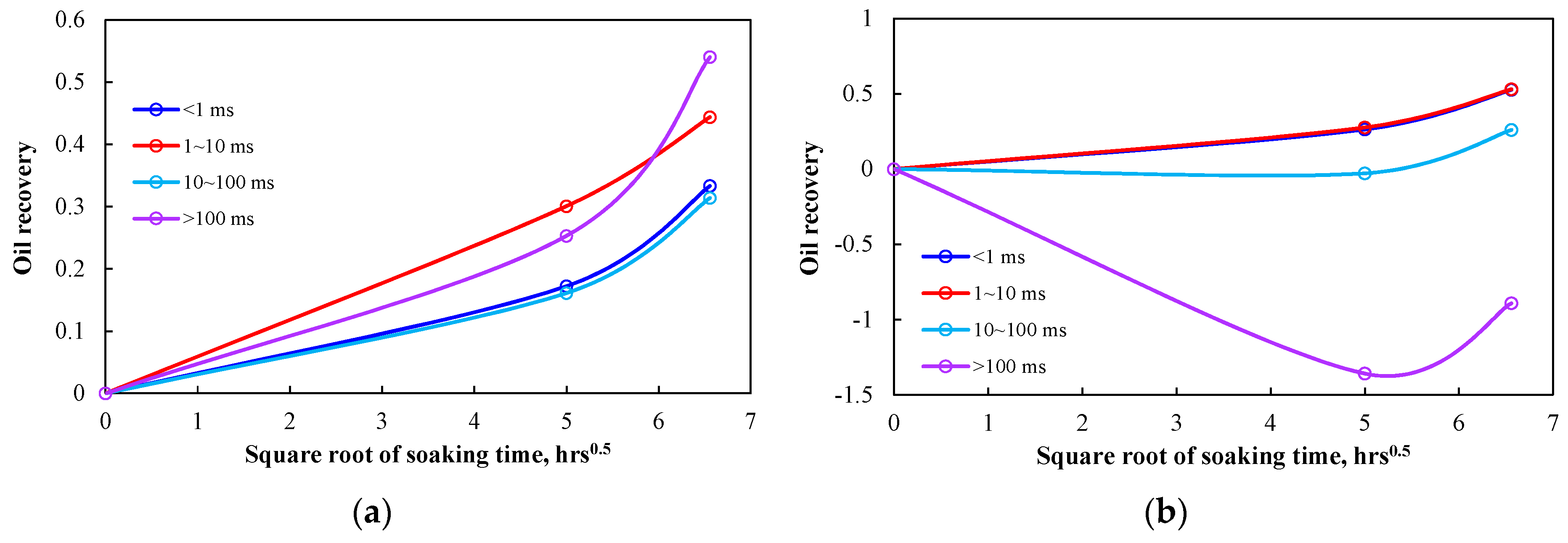
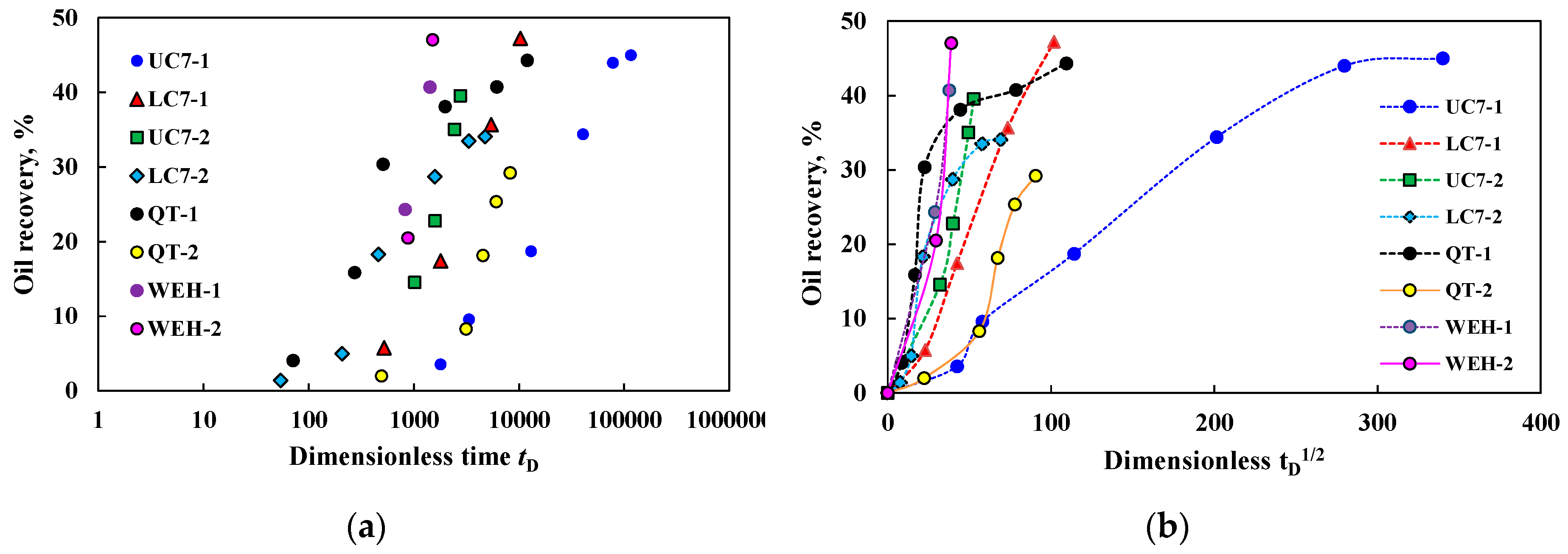

| Label | Formation | Diameter, cm | Length, cm | Porosity, % | Permeability, mD |
|---|---|---|---|---|---|
| UC7-1 | Upper Chang-7 | 2.49 | 5.1 | 3.2 | 0.24 |
| UC7-2 | 2.51 | 3.8 | 2.5 | 0.15 | |
| LC7-1 | Lower Chang-7 | 2.50 | 3.6 | 4.8 | 0.0062 |
| LC7-2 | 2.50 | 4.3 | 5.3 | 0.0053 | |
| QT-1 | Quantou formation | 2.50 | 3.5 | 8.1 | 0.014 |
| QT-2 | 2.52 | 5.2 | 9.8 | 0.008 | |
| WEH-1 | Wuerhe formation | 2.51 | 3.8 | 6.5 | 0.098 |
| WEH-2 | 2.50 | 3.2 | 8.9 | 0.12 |
| Label | Total Mineral Composition, wt.% | Relative Clay Abundance, wt.% | ||||||||
|---|---|---|---|---|---|---|---|---|---|---|
| Quartz | Feldspar | Calcite | Dolomite | Clay | Smectite | Illite | I/Sa | Chlorite | Kaolinite | |
| UC7 | 39.6 | 35.8 | 9.3 | 0 | 15.3 | 0 | 57.2 | 28.6 | 6.8 | 7.4 |
| LC7 | 45.2 | 29.4 | 12.8 | 0 | 12.6 | 5.7 | 23.6 | 42.8 | 8.3 | 19.6 |
| QT | 25.6 | 33.8 | 16.9 | 0 | 23.7 | 13.2 | 17.8 | 32.3 | 25.4 | 11.3 |
| WEH | 26.4 | 11.4 | 15.7 | 6.1 | 40.2 | 21.9 | 17.9 | 43.5 | 0 | 16.7 |
| Fluid | Density, g/cm3 | Viscosity, cP | Surface Tension, mN/m |
|---|---|---|---|
| 15 wt% MnCl2 | 1.2 | 1.1 | 74.2 |
| Kerosene | 0.81 | 1.32 | 29 |
© 2019 by the authors. Licensee MDPI, Basel, Switzerland. This article is an open access article distributed under the terms and conditions of the Creative Commons Attribution (CC BY) license (http://creativecommons.org/licenses/by/4.0/).
Share and Cite
Yang, L.; Wang, S.; Tao, Z.; Leng, R.; Yang, J. The Characteristics of Oil Migration due to Water Imbibition in Tight Oil Reservoirs. Energies 2019, 12, 4199. https://doi.org/10.3390/en12214199
Yang L, Wang S, Tao Z, Leng R, Yang J. The Characteristics of Oil Migration due to Water Imbibition in Tight Oil Reservoirs. Energies. 2019; 12(21):4199. https://doi.org/10.3390/en12214199
Chicago/Turabian StyleYang, Liu, Shuo Wang, Zhigang Tao, Ruixi Leng, and Jun Yang. 2019. "The Characteristics of Oil Migration due to Water Imbibition in Tight Oil Reservoirs" Energies 12, no. 21: 4199. https://doi.org/10.3390/en12214199
APA StyleYang, L., Wang, S., Tao, Z., Leng, R., & Yang, J. (2019). The Characteristics of Oil Migration due to Water Imbibition in Tight Oil Reservoirs. Energies, 12(21), 4199. https://doi.org/10.3390/en12214199






